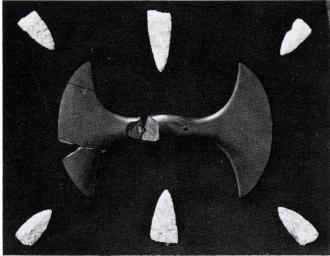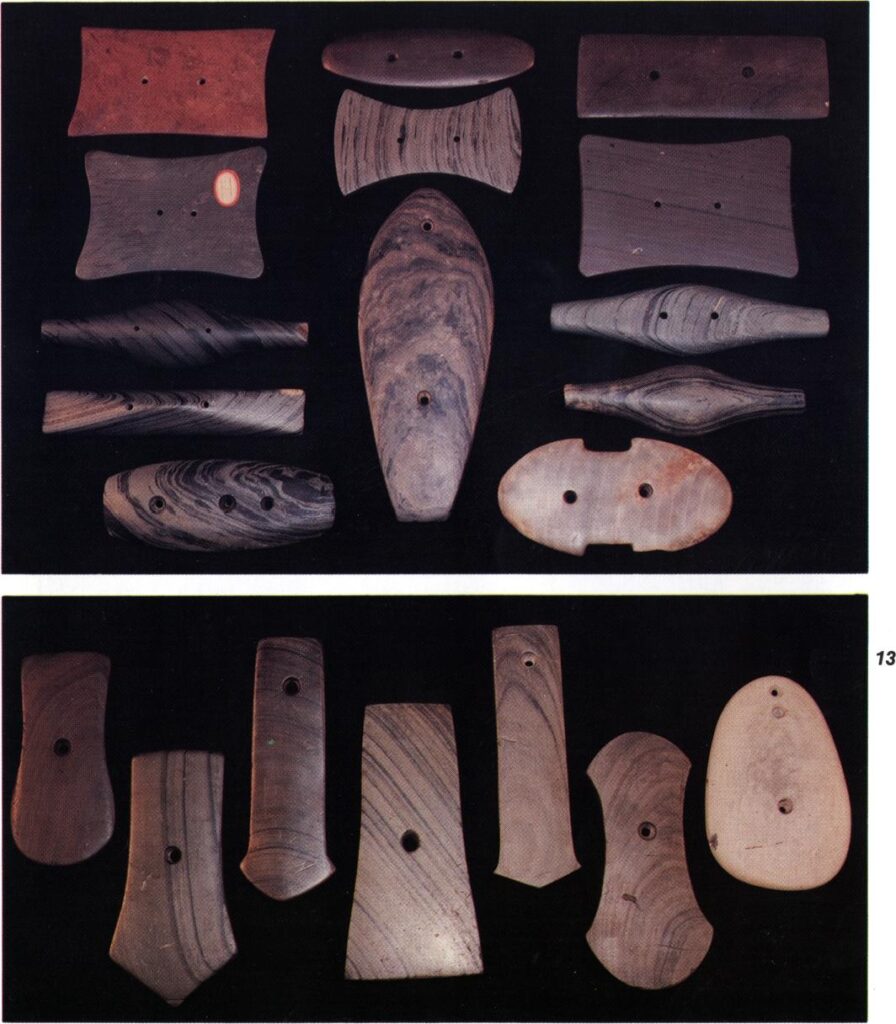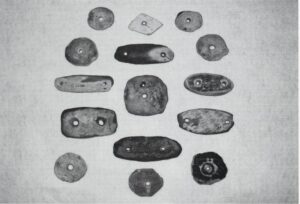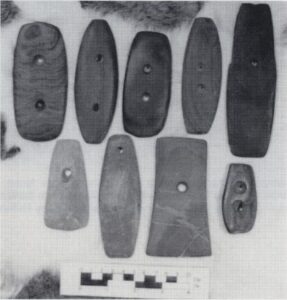By Bill Koup, Albuquerque, New Mexico
Personal adornment has always been an important pursuit of mankind. The wearing of specialized adornments for the purpose of appearing more attractive or to signify an individual’s rank, wealth or status has been documented with great regularity throughout the entire scope of mans’ history. Even the scarification and tattooing of skin has frequently signified great wealth or high status with particular societies. The use of various forms of jewelry and other decorative embellishments to the body or clothing has long been and probably always will be a popular and significant form of personal expression for nearly all humankind.
The prehistoric peoples of North America were in no way different to other societies in this regard. Literally thousands of artifacts including pendants and gorgets have been recovered that have no apparent use other than to enhance the owner’s personal presence. Some of these artifacts are most certainly akin to jewelry. Many of these items were worn to please the owner and to perhaps impress others of their personal wealth or sexual attractiveness. Certainly, there were many other types of adornments other than pendants and gorgets made and worn for the express purpose of signifying status within their respective societies. Perhaps a good anology would be the various patches and insignias worn by military personnel to designate rank, service and prestige. Another anology would be pins, watches, money clips and other items that have been awarded to individuals for their distinguished service at their place of employment. Even designer clothing with specific logos may be considered late 20th century manifestations of the desire for people to adorn themselves in ways to exhibit wealth or status.
So, are pendants and gorgets merely items of personal adornment worn to impress others or to signify status or wealth? Although no one at this time can be absolutely certain of the specific meaning of pendants and gorgets, chances are pretty good that is exactly what they are. Unlike many other artifact types whose specific purpose and use is highly speculative, pendants and gorgets appear to have been used as items of status, societal affiliation and certainly for personal adornment. Indeed, there is a significant body of documented archaeological evidence illustrating the fact that pendants and gorgets were worn as items to be proudly displayed on the body or clothing of the owner.
Pendants and to a lesser degree gorgets, have been discovered in nearly all areas of North America and among nearly all prehistoric cultures. They have been located in controlled archaeological excavations and on the surface as isolated field finds. Although most areas of North America had at one time supported pendant and gorget producing people, the Midwest and South seem to be centers for the production of these interesting forms.
Indeed, the Glacial Kame, Adena, Hopewell, Ft. Ancient and Mississippian cultures from Ontario,Canada, throughout the Great Lakes areas down the Ohio and Mississippi River valleys all produced various distinctive pendant and gorget forms. So distinctive and stylistically similar are many of these forms that it has become relatively easy to identify them as having been produced by a specific culture. It is even possible to identify some types of gorgets and pendants as being either early, middle or late in the scope of a particular society’s existence.

The Glacial Kame people were prolific gorget makers. Numerous styles and types exist and all are very interesting in their variety. Take for example the magnificent gorget illustrated here and on the cover. Although there are very few Glacial Kame Constricted Center Gorgets found in collections, the type is so distinctive in its shape and immense size as to be immediately recognized for what it is. Giant gorgets of this type are nearly always made from black cannel coal. This particular gorget was found in the early years of this century along with the surrounding flint artifacts in Allen County, Indiana. It is now in the collection of Ken Simper of Hamilton, Indiana. It’s always risky to make this kind of statement, but this cannel coal gorget is certainly one of the largest prehistoric gorgets ever discovered.
Midwestern collectors are capable of culturally typing many other pendant and gorget forms due to the numerous examples that have been found along with well documented, controlled archaeological research. Adena gorgets whether biconcave or quadraconcave or expanded are particularly distinctive and readily identifiable. Pendants are also easy to type culturally due to their distinctive shapes. Whether it is a Woodland Anchor Pendant, Hopewell Shovel Pendant or Mississippian Rattlesnake Gorget, the styles are so distinctive and their numbers are great enough to be recognized as a definite type from a particular culture.
Yes, pendants and gorgets can be found in a multitude of shapes, sizes and materials. The beauty of their forms has long been seen as high artistic expresion from prehistoric Americans. It is hoped that as you study the photographs found within these pages, you too will be impressed with the pleasing designs created by prehistoric Americans. After all, wasn’t impressing their peers with the wearers’ status, wealth or sexuality what they were created for?

Top Photo — Various gorget forms from Indiana, Ohio and Kentucky. Left column, top to bottom: Warren Co., Ohio; Licking Co., Ohio; Franklin Co., Indiana; Sandusky Co., Ohio; Medina Co., Ohio. Center column, top to bottom: Hematite gorget, unknown provenience; Adams Co., Indiana; Indiana. Right column, top to bottom: Knox Co., Ohio; Summit Co., Ohio; Tippecanoe Co., Indiana; Fleming Co., Kentucky; Richland Co., Ohio. Lower Photo — A variety of pendant forms and one gorget from Ohio and Indiana. From left to right: Keyhole, Indiana; Pentagonal, Summit Co., Ohio; Anchor, Franklin Co., Ohio; Trapezoidal, Huron Co., Ohio; Anchor, Geauga Co., Ohio; Biconcave, Tuscarawas Co., Ohio; ConcavoConvex Gorget, Hancock Co., Ohio. Collection of Bill Koup, Albuquerque, New Mexico.
Article used with permission by Bill Koup, Author




